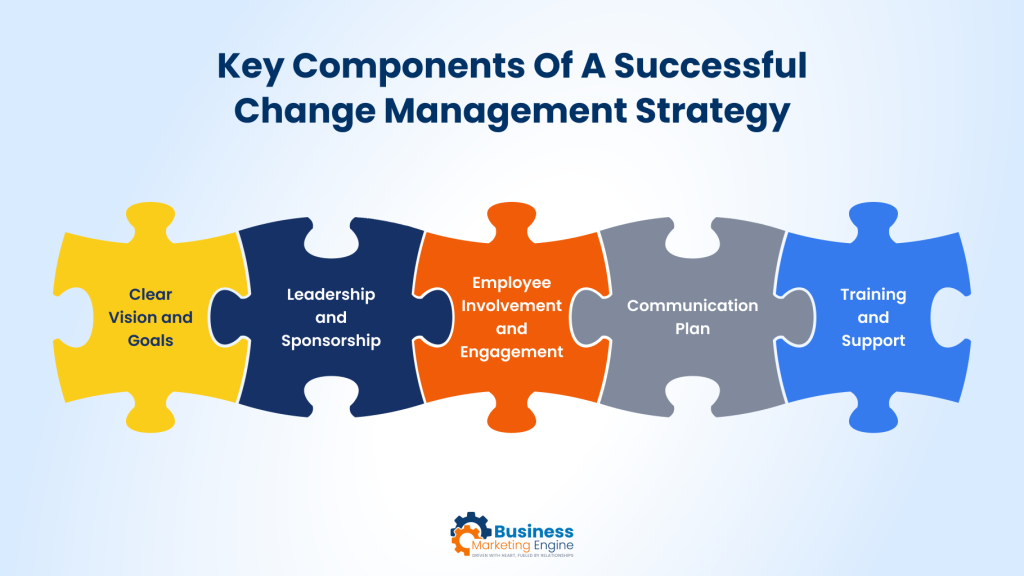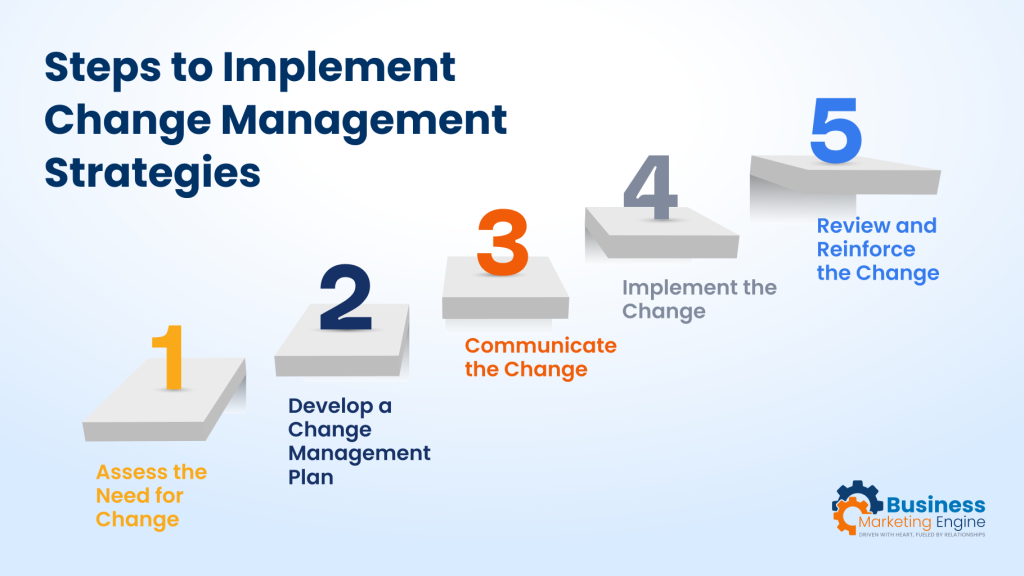In today’s dynamic world of business, change isn’t simply inevitable; it’s a constant.
However, we can reduce potential negative impacts with a little foresight and planning.
By creating effective change management strategies, businesses will be able to take back control during unpredictable times.
The result of effective change management? Smoother transitions and a solid foundation for ongoing business growth and success.
Join us as we dive into the steps business leaders can take to skillfully execute change management strategies.
What is Change Management?
So, what exactly are these change management strategies?
Quite simply, they’re your game plan for periods of change. Their aim? To shield your business from any negative fallout.
Changes in your business can include:
- Technological
- Structural
- Cultural
- Process-related shifts
The best way to combat these changes is to create a plan!
What is the Importance of Change Management?
Did you know that effective change management strategies can minimize a business’s resistance to change?
On the other hand, poor change management can lead to decreased employee morale, confusion, and a decline in productivity – ultimately harming your business.
Key Components of a Successful Change Management Strategy
Now let’s walk through all of the components you’ll need for managing change.
Clear Vision and Goals
The first one? Setting a clear vision and goal for your organization before the change occurs!
Defining these goals ensures everyone is aligned and focused on measurable outcomes. This can provide direction for your company in uncertain times while helping employees understand the “why” behind the transformation.
Leadership and Sponsorship
As your employees settle into this adjustment, it’s important to invest in a strong leader.
Leadership plays a critical role in driving change management strategies. It sets the tone, provides direction, and allows others to model successful behavior.
Start by pinpointing your “change sponsors” within your organization. These are the people who are committed to the change and can advocate for it across teams.
These sponsors can help drive engagement, address concerns, and rally support, ensuring the change is embraced at all levels of your organization.
Employee Involvement and Engagement
It’s important to remember that change affects everyone within the organization.
When employees are part of the conversation, they’re more likely to understand the reasons behind the change and feel valued in the process.
Strategies for gaining employee buy-in include:
- Actively listening to their concerns
- Providing clear expectations and explanations
- Offering opportunities for feedback
- Addressing concerns promptly and with detail
- Providing ongoing support
Involving employees in this process can foster a sense of trust, which can reduce resistance and create a smoother transition.
Communication Plan
Don’t forget to develop a comprehensive communication strategy to keep stakeholders informed during times of change. You should provide:
- Transparency – Be clear about your business’s goals and objectives with everyone involved
- Consistency – Stay up-to-date on timelines
- Timely Communication – Be clear on any updates or modifications
Training and Support
Continue to help employees by providing them with the necessary training and resources to adapt to change.
This training should be tailored to the specific needs of different teams and be delivered in a variety of formats to accommodate various learning styles.
You can also utilize support systems like coaching and mentoring to offer personalized guidance.
Steps to Implement Change Management Strategies
Now, let’s walk through the steps to implement a strong plan that’s effective during change!
Step 1: Assess the Need for Change
Start by conducting a thorough analysis of your business environment and identify areas for improvement. Don’t forget to involve key stakeholders in the assessment process, as everyone needs to stay informed.
Step 2: Develop a Change Management Plan
You’re going to need to make a detailed plan that outlines the change objectives, timeline, resources, and roles. You must ensure the plan is flexible enough to accommodate adjustments.
Step 3: Communicate the Change
Create an effective communication plan to roll out to all levels of the organization. In this plan, be sure to address questions and concerns to prevent resistance.
Step 4: Implement the Change
Execute the change management plan with a focus on maintaining business continuity. Be sure to create strategies for maintaining momentum and overcoming resistance.
These can include:
- Setting clear, short-term goals
- Celebrating small wins to maintain motivation
- Communicating regularly to keep everyone informed and aligned
- Anticipating and addressing obstacles proactively
- Ensuring visible leadership engagement to reinforce commitment and support
- Offering support systems (e.g., coaching, mentoring) to help employees navigate challenges
- Staying flexible and adjusting the approach as needed to overcome unforeseen hurdles
Step 5: Review and Reinforce the Change
The final step is to review the outcomes of the change management process to ensure all objectives are met. You may need to tweak your strategy based on feedback or challenges that arise.
Overcoming Challenges in Change Management
Naturally, issues will occur when you start to implement change management strategies. Here’s how to overcome them.
Resistance to Change
Resisting change is inevitable – people are naturally scared of the unknown.
To effectively overcome this resistance, make sure to involve employees early in the change process. Allow them to share their concerns, ask questions, and offer feedback.
Trust must also be carefully cultivated through open, honest, and transparent communication. Leaders should clearly explain the reasons behind the change, outline the expected benefits, and reassure employees that their well-being is a priority.
When employees feel valued, they are more likely to embrace change.
Maintaining Business Continuity
Understanding how to balance the need for change with the ongoing operations of your business is crucial for success.
Here are some tips for minimizing disruption during the change process:
- Cross-train employees to ensure coverage during transitions
- Plan for any necessary downtime during off-peak hours
- Communicate expectations
- Implement changes in phases to avoid overwhelming staff and minimize operational impact
- Stay flexible and adjust the plan as needed to ensure smooth operations
Adapting to Unexpected Issues
Imagine you’re overseeing a project for your company, and midway through, a vendor fails to deliver.
What happens now? Chaos!
But, instead of stalling, your team quickly moves to find alternative vendors, shifting priorities without compromising the overall objective.
Flexibility in change management means being proactive in identifying potential problems, reactive in handling them efficiently, and resilient in learning from them.
Conclusion
Take a moment to assess your organization’s readiness for change—are you fully prepared for the next phase of growth?
If you need some extra support, our team has helped thousands of businesses achieve exceptional results, even in times of change.
Contact us today, and let’s work together to ensure your business is fully equipped with the best change management strategies!






